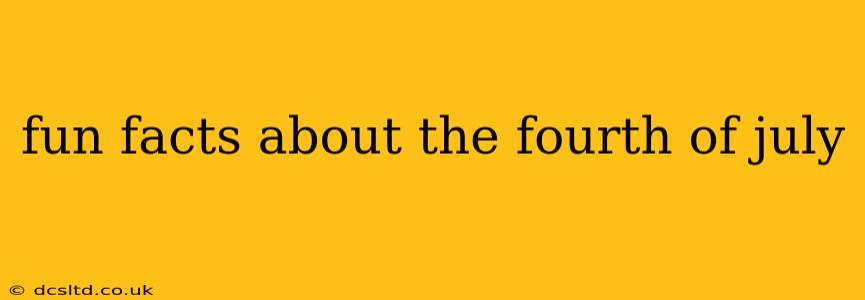The Fourth of July, or Independence Day, is more than just barbecues, fireworks, and parades. It's a celebration steeped in history, brimming with fascinating stories and quirky details often overlooked. This year, let's delve deeper into the holiday and uncover some truly fun facts that will impress your friends and family!
What is the Significance of the Fourth of July?
The Fourth of July commemorates the adoption of the Declaration of Independence by the Continental Congress in 1776. This document declared the thirteen American colonies independent from Great Britain, marking a pivotal moment in the birth of the United States. It wasn't an immediate victory, of course, the Revolutionary War raged on for several more years, but the declaration itself was a bold and powerful statement of self-determination.
What did the Continental Congress actually do on July 4th, 1776?
The Continental Congress didn't actually sign the Declaration of Independence on July 4th. The engrossed copy (the official, handwritten version) was signed later, in August. July 4th was the day the Congress voted to approve the document. This formal approval is what we commemorate.
Why are fireworks associated with the Fourth of July?
The association between fireworks and Independence Day began soon after the signing of the Declaration. Fireworks displays were a common way to celebrate public events, and the newly declared independence provided ample reason for celebration. The dazzling lights and booming sounds symbolized the burst of freedom and the nation's new beginning.
Was the Declaration of Independence immediately popular?
While the Declaration of Independence is now a cornerstone of American identity, its reception wasn't universally enthusiastic at the time. Many colonists remained loyal to the British Crown, and the declaration was met with a mixed reaction. Furthermore, it wasn't widely distributed or read immediately by all colonists; news traveled slowly back then.
What other traditions are associated with the Fourth of July?
Beyond fireworks, the Fourth of July has evolved to incorporate a range of beloved traditions. These include parades showcasing patriotism, family picnics and barbecues emphasizing community, and patriotic speeches and ceremonies commemorating the day's historical significance. The tradition of ringing church bells also goes back to the era of the American Revolution, marking celebrations.
When did the Fourth of July become an official federal holiday?
It took quite a while for the Fourth of July to become a nationally recognized holiday. While celebrations existed early on, it wasn't until 1870 that it became a federal holiday under a law proposed by Representative Benjamin Butler. This finally gave federal employees the day off to celebrate!
What are some lesser-known facts about the Declaration of Independence?
The Declaration of Independence was written primarily by Thomas Jefferson, but it underwent revisions and edits by the Committee of Five, which also included John Adams and Benjamin Franklin. The original copy of the Declaration is fragile and requires special preservation efforts. Interestingly, Jefferson's original draft contained a passage condemning slavery, which was ultimately removed during the editing process.
How is the Fourth of July celebrated around the world?
While the Fourth of July is primarily a celebration within the United States, American embassies and communities abroad often host celebrations to mark the day. This spreads the spirit of Independence Day to a global audience.
The Fourth of July continues to evolve as a holiday, remaining a testament to the enduring pursuit of freedom and self-governance. While fireworks and barbecues are a lot of fun, remember to take a moment to reflect on the meaning behind the holiday and the sacrifices made by those who fought for our nation's independence.
